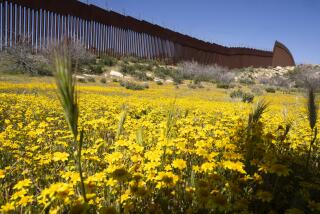Texas Is for the Birds, Happy Bird-Watchers Say
- Share via
LAGUNA ATASCOSA NATIONAL WILDLIFE REFUGE, Texas — Binoculars dangling from his neck and a spotting scope propped heavily on his shoulder, Tom Bormann takes a water break before embarking on another forest-lined trail.
Red-faced and sweaty, Bormann guzzles mineral water as he flips open a worn field guide and pulls out an index card, proudly displaying the eight new species of birds he’s spotted while in the Rio Grande Valley.
“You can get more birds in the state of Texas than almost any other state. It’s a top-10 spot on anybody’s list,” says Bormann, a St. Louis insurance salesman on his second bird-watching trip to South Texas.
Bormann is proof: Birding is booming.
“It’s an addiction. It is considered the fastest-growing hobby in North America,” said Tom Pincelli, one of the creators of the Rio Grande Valley Birding Festival held recently.
A 1992 report by the Department of the Interior found that 63 million Americans have expressed an interest in birds, and 30 million people travel expressly for wildlife viewing. The American Birding Assn. in Colorado Springs, Colo., estimates bird-watchers spend $18 billion annually on travel and equipment.
“It’s a really good way for people to commune with the out-of-doors,” said Greg Butcher, executive director of the organization, which has grown from 6,000 members to 16,000 in five years. “A lot of people get stuck inside with office jobs and indoor tasks, and they’re looking for a good excuse to get outside.”
About 2,000 birders from 41 states and Canada have flocked to the Rio Grande Valley festival, which doubled in attendance and length in just its second year.
Birders of all levels of experience can learn everything from how to identify a bird by its sound to how to landscape to attract feathered friends.
“A lot of these birds that are rare in other parts of the United States you can see just walking around neighborhoods here,” said Nancy Millar, a Harlingen Chamber of Commerce official who started the festival last year.
Texas is the No. 1 North American destination for birders, according to the Texas Parks and Wildlife Department. More than 100,000 people travel annually to the valley’s three primary nature preserves.
The region’s popularity is due to the 465 species of birds found here, at least 34 of which are rare.
South Texans have begun to take note of their valuable commodity. Ranchers are starting to open their properties to bird-watchers as well as hunters, and tour companies have added bird-watching excursions.
Last year, the festival brought $266,000 to the Valley. The total economic impact from this year’s event is an estimated $1.5 million, Millar said.
The Harlingen Chamber of Commerce estimates that $22.5 million is spent annually on bird-watching in the region. The total economic impact is about $79 million.
Sanborn’s Viva Tours in McAllen began giving birding tours three years ago, and bookings have doubled every year, said tour guide Hugh Crane.
More to Read
Sign up for The Wild
We’ll help you find the best places to hike, bike and run, as well as the perfect silent spots for meditation and yoga.
You may occasionally receive promotional content from the Los Angeles Times.






